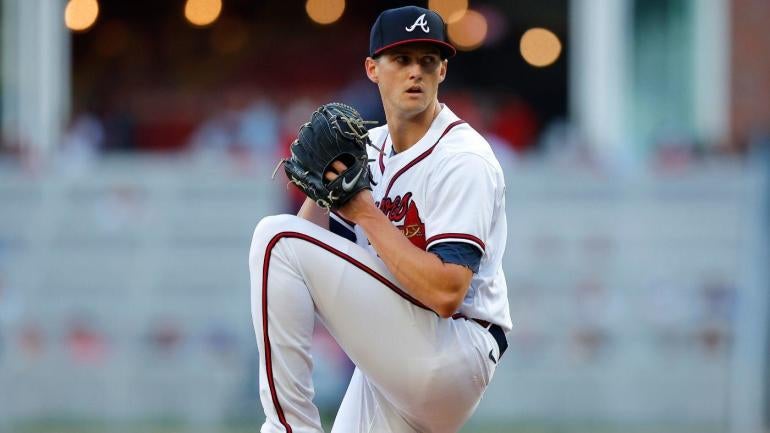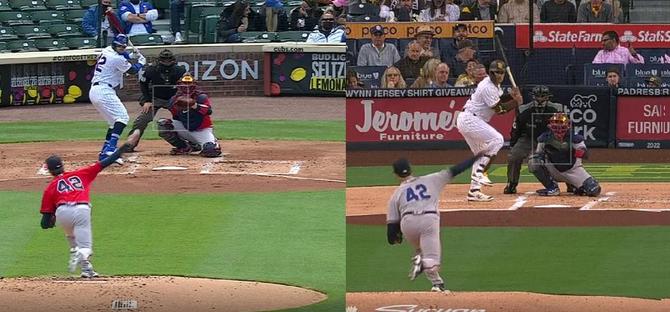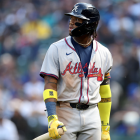
An important lesson in baseball analysis is that development isn't always linear. Past growth does not always precipitate future growth, and the appearance of stagnation does not cement that no improvement is possible. Players are human beings, and human beings are largely unpredictable creatures who learn skills and their applications at varying paces and to varying efficacies. That's life and sport for you.
Kyle Wright, who will start for the Atlanta Braves on Thursday against the Chicago Cubs, is a carbon-based validation of the sentiment. In his first three starts this season, he's posted Game Scores that rank as the second, third, and fifth best for his career. He entered this season with a career ERA (6.56) that was a little too close to his strikeout rate (7.6 per nine) for anyone's comfort. So far this year, in a small sample size to be sure, he's rocking a 1.06 ERA (387 ERA+) and a 13.00 strikeout-to-walk ratio.
Wright's performance would be notable enough on its own -- he's a former top-five draft pick who pitches for the defending champions, after all -- but the underpinning beneath his rise makes it more impressive, for here is a pitcher who has changed almost everything in a single offseason. That isn't an exaggeration, either: Wright has a new release point and pitch mix to go along with new velocity and movement.
Let's dive into each of those areas to highlight what's different, as well as how those tweaks have allowed him to achieve a higher level of performance.
1. Release point
We'll start with Wright's most obvious aesthetic tweak. He's both dropped his arm slot and gained depth on his release point. The first part of the equation is usually easy to notice. Here, it was challenging to find good camera angles that show the difference in a clear manner. Trust us, though, that there is a difference.
Below, you'll see two screenshots of Wright at release. The image on the left is from 2021, the other is from 2022. In both cases he's throwing a fastball. (To control for his changes in pitch usage, we're only using release data on his fastballs in this section to more clearly illustrate the difference.) Wright's arm is about four inches lower this year. Observant readers will note that he's also pitching from a different spot on the rubber, but that isn't driving his release height difference: he released from a similar spot on the mound in 2020, and his release height then was still five inches higher than it is now.

As for the second part, it's important to not think of a release point in two-dimensional terms. The problem is that, in contrast with the arm slot, it's harder to get a firm read on how far the pitcher gets down the mound from a TV shot.
Thankfully, the advent of ball-tracking technology answers the question for us in the form of a metric called "extension," or the distance (in feet) from the pitching rubber to the ball's point of release. Wright is generating 6.71 feet of extension on fastballs this season. His previous career-high in that category was 6.32 feet.
Shrinking the amount of distance the ball has to travel means that batters have less time to react to the pitch, in turn making it play faster. Wright has gained raw velocity on his heater this season, but he's also gained what's referred to as effective or perceived velocity. Put another way, Wright's effective velocity on fastballs this season is 0.8 mph faster than his raw velocity. Last season, there was no difference. In both 2020 and 2019, his effective velocity was actually lower than his raw velocity, meaning his release point made his pitches play slower than they were.
Kyle Wright, Back to Back Elevated 97mph ⛽️⛽️ pic.twitter.com/jbHZDTiG6q
— Rob Friedman (@PitchingNinja) April 23, 2022
There's one other optical component we'll touch on here: it's the concept of approach angle, or essentially the path the pitch takes on its flight. The rule of thumb in the industry is that pitchers should want an extreme vertical approach angle, meaning either their pitches take close to a straight line or they take an extreme path down (or up, in the case of submariners).
By flattening his release point, as well as locating his fastball up in the zone more frequently, Wright has changed his vertical approach angle from 4.92 degrees to 3.91 degrees. That's the difference between ranking in the 97th percentile in that category (among pitchers with 50-plus fastballs) and ranking in the 37th percentile.
Of course, tweaking the release point can also have an impact on a pitcher's velocity and movement.
2. Velocity and movement
We referenced Wright's effective velocity in the prior section. Rest assured, his raw velocity is up, too. His fastball is averaging 95.3 mph instead of 93.6 mph, a 1.7 mph gain that ranks near the top of the majors in velocity improvements. Wright's other pitches have benefited from his increased oomph, too. He's throwing his curveball nearly four ticks hotter, up to 84 mph, and his changeup is also up nearly a full mph.
| Pitch/velocity | 2021 | 2022 | Net |
|---|---|---|---|
Fastball | 93.6 mph | 95.3 mph | +1.7 mph |
Curveball | 80.6 mph | 84.3 mph | +3.7 mph |
Changeup | 86.8 mph | 87.7 mph | +0.9 mph |
As for the movement component, Wright's fastball now features several more inches of horizontal break than he's thrown in the past -- an unsurprising development given his aforementioned release point change. His harder curveball has reduced horizontal and vertical break, while his changeup is diving more.
Kyle Wright, Sick 87mph Breaking Ball. 🤒
— Rob Friedman (@PitchingNinja) April 23, 2022
11th K. pic.twitter.com/RVDQ6jg6HP
Predictably, Wright has adjusted to his altered arsenal by changing his usage patterns.
3. Pitch mix
The easiest way to sum up Wright's game plan tweaks is that he's ditched his slider-slash-cutter while ratcheting up his secondary stuff usage overall.
| Pitch/Season | 2021 | 2022 | Net |
|---|---|---|---|
Fastball | 51.9% | 44.1% | -7.8% |
Slider | 27.1% | 0.0% | -27.1% |
Curveball | 14.3% | 33.8% | +19.5% |
Changeup | 6.8% | 15.2% | +8.4% |
Wright had thrown that slider-slash-cutter more than 25 percent of the time over the last two seasons. The results weren't good, however, and it doubled as his pitch that most frequently ended up in the stands. Roughly 56 percent of Wright's pitches this season have been of the "soft" variety, but now they're all curves and changeups. He's throwing his breaking ball more than a third of the time overall, and he's emphasized his cambio in a way that he had not previously done during his big-league career.
These things can be difficult to judge from the outside or on a predictive basis, but so far Wright seems to have made the correct call in both respects. He's not only delivering a higher percentage of strikes (69 percent versus in the low-60s prior), he's also missing more bats and enticing more swings outside of the strike zone.
The new Kyle Wright, then, went from changing everything about his game to delivering all you can ask for from a pitcher.
























